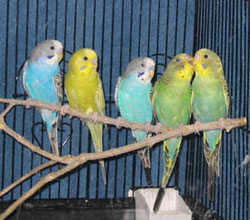
Budgerigar, orCommon pet parakeet, orShell parakeet, or Budgie(Melopsittacus undulatus)
Phylum —chordata
Class — aves
Order — psittaciformes
Family — psittaculidae
Genus – melopsittacus
Appearance
Budgerigars are small, streamlined parrots that average 18-20 cm in length. They are unlikely to be mistaken for any other parrot because of their small size, pointed wings and tails, and distinct plumage patterns. Most wild budgerigars have a yellow forehead (juveniles have a barred forehead), a yellow and black striped head with purple and black markings on the cheeks, a pointed bill whose tip of the upper mandible extends over the lower mandible, and a yellow throat. Their lesser and median wing coverts are centered black and outlined in yellow. Both their greater coverts and flight feathers are centered black and outlined with green and yellow, but their flight feathers also have a central yellow bar. Their uppertail coverts are bright green and extend to a blue-green tail. Caged species differ greatly in their plumage color and patterns.
There is slight sexual dimorphism. In breeding females, the cere (the skin at the base of the bill, covering the nostrils) is light brown or beige. Otherwise the cere is blue.
Habitat
The budgerigar, is naturally distributed through Australia except for coastal areas in the far east and the far south-west. This species has also been introduced to many areas around the world including S. Africa, Japan, U.S., Puerto Rico, Switzerland, and New Zealand, however, they have only successfully been established in southwest Florida.
Behavior
Budgerigars aggregate into large flocks and are strongly social. Their grouping allows for greater success in feeding and also helps in protection from predators. There does not seem to be any hierarchy in groups based upon the relatively few battles among individuals, but females are generally more aggressive than males.
Their activity, like most birds, begins just before sunrise with preening, singing, and movement within trees. After sunrise, the birds fly to the foraging area and feed throughout the day. They do not forage during midday or in extremely hot weather, instead they take shelter under shade and remain motionless. At the end of the day, they congregate by calling loudly and flying at high speeds around the trees. They then return to their roosting site just after sunset and remain at rest until the next morning.
Diet
Budgerigars are highly successful exploiters of food and water resources whenever available. They are ground-feeders and thus prefer to take the seeds of grasses and crop plants, particularly spinifex and tall tussock grasses. They first dehull the seed and then swallow it whole or broken. These seeds are extremely energy rich and are equivalent to the caloric content of animal tissue. Therefore, no alternate food source is necessary. Budgerigars are very scheduled in their drinking habits and drink about 5.5% of their body weight daily. To satisfy this demand, they often locate themselves near water holes.
Reproduction
Budgerigars are monogamous and breed in large colonies throughout their range.
Breeding for budgerigars can occur during any time of the year but most frequently occur with an abundance of seed. Most grass seeding occurs during the winter in northern Australia and during the spring and summer in southern Australia. This means budgerigars also breed after heavy rains because grass growth is dependent upon water.
Budgerigars make their nest in pre-existing cavities that are available in fence posts, logs, and Eucalyptus trees. Several nests can be found on the same tree branch measuring only 3-5 m apart from one another. They fill their nests with decayed wood dust, droppings, and any other soft material available. The female chooses the nest site and incubates while the male spends most of the time foraging and feeding all until the chicks are ready to fledge. The parents often have several broods in succession.
In captivity
They live up to 21 years in captivity.
Providing a cage large enough is important for all birds, so they can stretch their wings and exercise by flying from perch to perch. For a solo budgie, a 12” long, 18” wide and 18” high cage is required at minimum, but keeping more than one together will require a bigger space. Make sure your feathered friends have lots of time to fly freely outside their cage too, always under supervision and with doors and windows safely shut.
Inside the cage or aviary, provide a variety of perches. Dry and untreated natural branches are best – the uneven surface is good for maintaining healthy nails and feet and the birds will enjoy stripping the bark with their beak, a natural behavior in the wild. Budgies are active and love to play, so accessorising their home with toys such as mirrors, bells and rope ladders will keep them happy and stimulated. Rotating these toys regularly will add variety and extra interest.
A ground covering of newspaper can be refreshed quickly and easily, as well as being kind to budgie’s feet. A fine layer of grit on top of this, which budgies will happily peck and scrape, will help with their digestion.
Keep their cage safely away from drafts, direct sun and other pets. Their talkative character can mean that they might not be ideal office buddies, but avoid keeping them in the kitchen as cooking fumes can be harmful.
Provide fresh water and feed daily, but be careful not to overindulge budgies as they can become overweight. As well as a good quality seed mix, you can treat them to small amounts of organic fruit and vegetables, offering extra nutrients and variation to their diet. Double check that the foods you give them are safe, as some, such as avocados, are surprisingly bad for birds.
 Russian
Russian
 English
English























